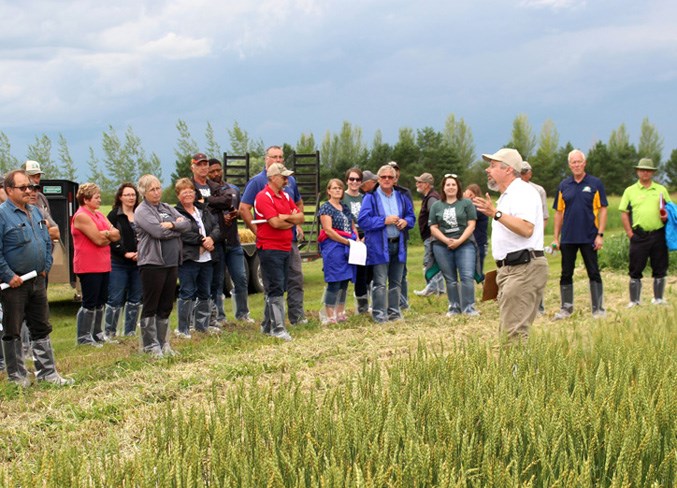With thunder and lightning in the background, the Lakeland Agricultural Research Association (LARA) showed what they’ve been working on this summer.
LARA gave attendees the opportunity to take a walk through the field and look at the crops at their Fort Kent research facility on Tuesday, July 30.
“We take this day to invite farmers, some of our partners, and funders out to view the work that we’re doing,” explained Alyssa Krone, manager for LARA.
Ultra early wheat seeding, regional variety trials, liming, and crop rotations were among the topics discussed.
Since LARA’s research is based on what local producers want to see, Krone noted it’s important to show what’s happening at the Fort Kent location.
“We’re a non-profit, and we’re funded by various different organizations, so we have an open door policy. Even during any other time of the year, people can call us up, they can come, we’ll show them around, and give them a tour.”
The organization’s collaboration with area farmers is one of the reasons MD Reeve Greg Sawchuk believes it’s a great group to have locally.
“We encourage people to come by, because LARA is producer-led. When producers come in and talk about a problem they have, then LARA can actually develop a trial around it.”
Participants climbed into wagons to head to the association’s 40-acre field for a tour.
One of the stops that peaked attendees’ curiosity was the Environmentally Smart Nitrogen (ESN) and fertilizing nitrogen trials on spring wheat and barley, also known as topdressing.
“There’s a lot of interest in the use of ESN and topdressing in this area,” said agronomy technician for LARA, Amanda Mathiot. “Lots of farmers are interested in it, but are a little scared or shy to try it because they don’t know exactly how it’s going to work on their operation, or if it’s economical. That’s what we’re trying to do, we’re going to try to gather information from our research to see how it works in this area and we provide that information to the farmers and producers later on.”
Mathiot described ESN as “nitrogen that has a green polymer coat” that releases when environmental conditions, such as soil moisture and climate, are just right.
When it came to topdressing, LARA sprayed liquid nitrogen on wheat at different times and stages.
“What we’re looking to see is if there’s an increase in yield or protein,” Mathiot said.
This is the first year LARA has conducted these tests. Mathiot said they will run the numbers after they harvest in the fall and determine if it worked.
LARA has a number of regional variety trials from SeCan, a Canadian seed company that supplies seeds to farmers, such as red spring wheat and barley.
Trent Whiting, marketing representative for SeCan, noted local producers are lucky to have these studies conducted in their own backyard.
“You can look, feel, and touch right at home versus going somewhere else and seeing it. What a variety looks like here actually can look different than say in St. Albert or in Vermilion, just because the weather is a little different and the soil’s different.”
He added, “I can show you our seed guide, I can even take the Alberta Seed Guide, and what you’re seeing there is a bunch of averages against a standardized check. It doesn’t tell you how they will do here. The other thing to remember is you take the Alberta Seed Guide or anybody’s seed guide, Alberta farms are as far south to north as the prairies are wide. There’s a huge geographical difference, and agroclimatic differs in there.”
Learning about the projects LARA has on the go was a highlight for local farmer Ulf Herde.
“It’s good to see the crops, and how the different varieties stack up against each other here, because it’s the only way to really see it where it’s all fair trials, because they’re not spread out all over the country,” Herde detailed. “They’re all done right there in one spot under ideal and similar conditions.”
Although the rain cut the tour short, Krone was hopeful participants were able to take away the importance of the research being conducted.
“The in the ground, in the field, and applied research that farmers can look at, understand, and take it directly to their farms and apply it, that’s what our main goal really is.”



